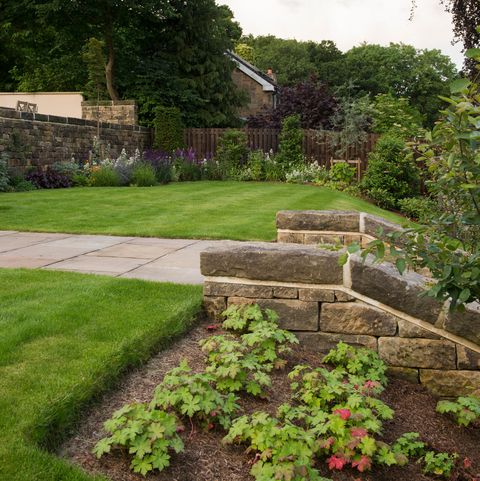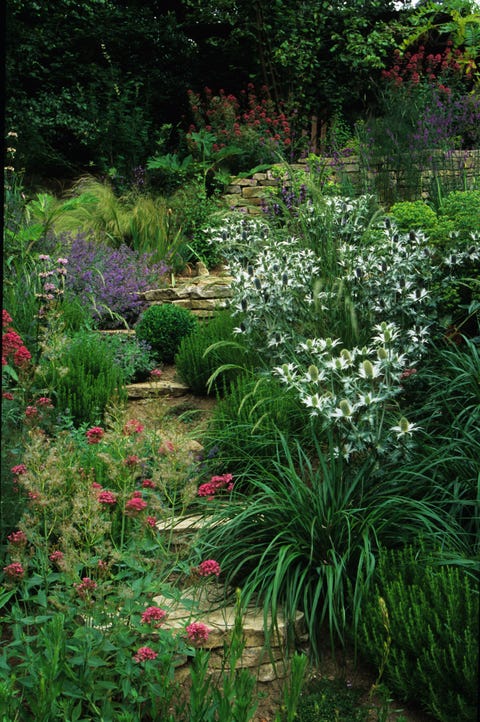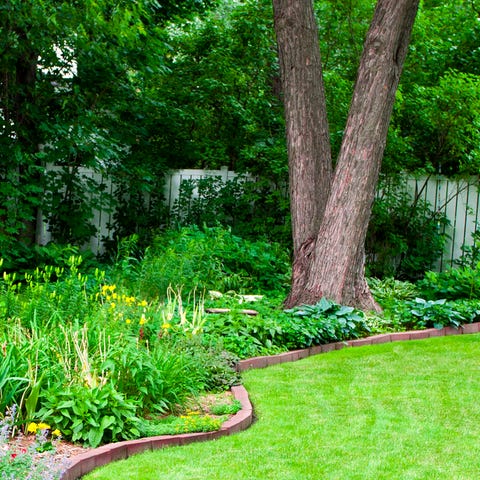How To Build A Raised Garden On A Slope

Ian Lamond / Alamy Stock Photo
Sloping gardens are perfect for water features and streams, but can often be problematic when it comes to planting flowers or designing a patio.
As well as being better for the foundations of your house, a levelled garden is more useable and less likely to cause flooding during rainy seasons. But what are the methods to utilising a sloping garden?
The experts at BillyOh have suggested a few tips to help gardeners decide how to cleverly make the most of their sloped garden.
1. Levelling
While one of the ways you can combat a sloping garden is to get it levelled out, it's worth knowing that levelling out a sloped garden takes a lot of time and money. The experts at BillyOh recommend avoiding this option if you can, as it could disrupt the foundations of your house. Always seek professional advice before going ahead.
2. Terracing
Introducing terraces to your garden will enable you to create different levels and various 'zones' to your space. You can also choose to level out different sections of the garden, so that you don't have to do it all at once.
Why not place a seating area at the top of the garden and use plants to frame it. You could also create a vegetable patch as a terrace, helping improve the drainage of water from the garden (this means it is being soaked up and put to good use).

John Glover / Alamy Stock Photo
See more ideas below:
This content is imported from Instagram. You may be able to find the same content in another format, or you may be able to find more information, at their web site.
This content is imported from Instagram. You may be able to find the same content in another format, or you may be able to find more information, at their web site.
This content is imported from Instagram. You may be able to find the same content in another format, or you may be able to find more information, at their web site.
3. Edges
Whatever your final plan is with the garden, ensure you leave an edge around it. This will provide you with the opportunity to boarder your space, while also meaning that your fences won't be destabilised.
This content is imported from Instagram. You may be able to find the same content in another format, or you may be able to find more information, at their web site.
4. Trees
Having well-rooted trees will provide a good foundation and help to keep the soil sturdy. Without these, strong wind and rain could cause erosion and see your garden wash away in heavy storms.

JenniferPhotographyImaging Getty Images
5. Foundations
When designing a garden, it has a large impact on the house's foundations. It's always best to seek the professional advice of an engineer before levelling out your space, especially if it's close to the building or a steep slope. Top tip: to help keep gardens and foundations safe, opt for materials such as railway sleepers, breeze blocks and natural stone to keep the soil in place.
Like this article? Sign up to our newsletter to get more articles like this delivered straight to your inbox.
SIGN UP
8 plants to help naturally deter garden slugs

Foxglove
These tall, elegant plants are not just great at attracting bees – they contain a large amount of nerve toxins which are repellant to slugs. They are also good at breaking up a border which may have become the perfect habitat for slugs – moist, low and shady. Foxgloves bring light, height and structure.
BUY NOW

Euphorbias
Euphorbias contain a latex-filled tissue which is repellant to many pests.
BUY NOW

Japanese Anemones
Similarly, Japanese anemones contain the same unpalatable tissue and provide a zap of colour to any border.
BUY NOW

Day lily hemerocallis
The striking flowers on these beautiful blooms are not our focus here, it's the fury stem that makes it hard for slugs to grip.
BUY NOW

Succulents
Succulents form a similar texture barrier with their waxiness and, with some varieties, spikiness. They are also very low-maintenance and add colourful structure.
BUY NOW

Astrantia
These delicate flowers may look sweet and innocent but their string scent is repellant for slugs.
BUY NOW

Salvias
Again, slugs detest the smell of this highly aromatic herb.
BUY NOW

Fennel
The bitter scent of fennel isn't attractive to them, either.
BUY NOW
This content is created and maintained by a third party, and imported onto this page to help users provide their email addresses. You may be able to find more information about this and similar content at piano.io
How To Build A Raised Garden On A Slope
Source: https://www.housebeautiful.com/uk/garden/designs/a28866118/sloping-garden-ideas/
Posted by: clarksonoblipt58.blogspot.com

0 Response to "How To Build A Raised Garden On A Slope"
Post a Comment